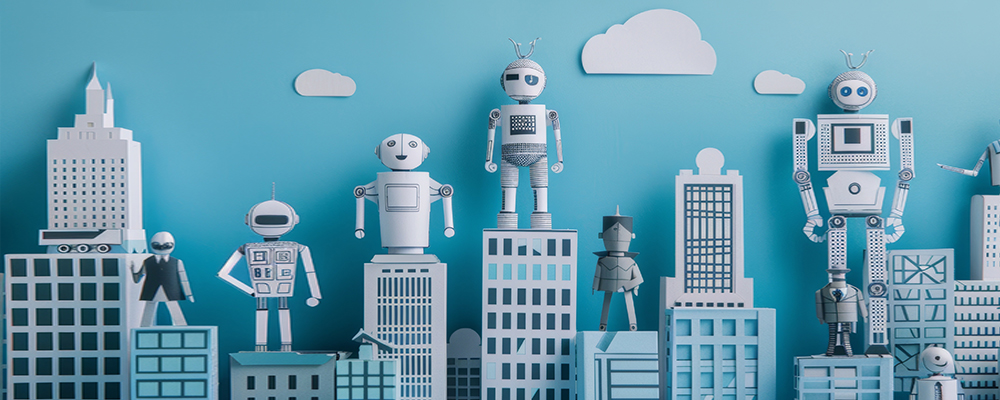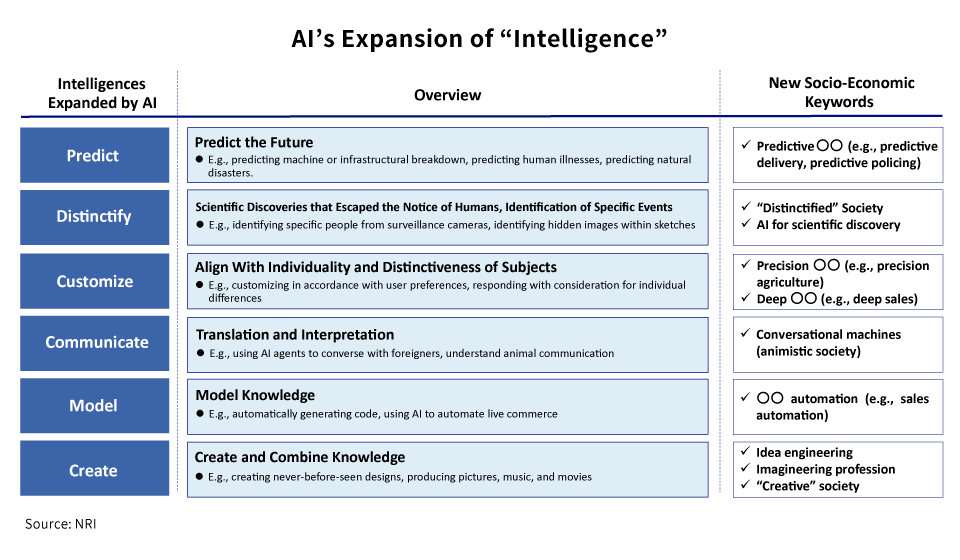
Healthcare & Service Industry Consulting Department: Kazushige Tsuchihashi, Ryo Yoshida, Akira Mukai
The relationship between AI and humanity is currently being examined from a variety of angles. At Nomura Research Institute (NRI), we regard AI as an “entity that will expand human intelligence” and have conducted a wide-reaching investigation of AI integration case studies through which we have identified six intelligences that AI will expand – specifically, “Predict”, “Distinctify”, “Customize”, “Communicate”, “Model”, and “Create”. This article introduces current integration case studies and potential future use cases regarding the six intelligences, while also estimating the scale of the spread of AI Agents, which are expected to be widespread in the near future. We spoke with Kazushige Tsuchihashi, Ryo Yoshida, and Akira Mukai of the Healthcare & Service Industry Consulting Department, all of whom are experts on the topic.
The Six Intelligences That AI Will Expand
“Predict” means the ability to predict the future. AI is currently being utilized to diagnose and predict water pipe failure risks and natural disaster risks on the basis of satellite images and other such data, and with research advancing on medical systems that can predict future illnesses previously unforeseeable by humans, the expansion of AI’s predictive power is well underway.
“Distinctify” means the ability to use massive data to uncover subject matter and patterns in particular events that have escaped human notice. Examples of this include AI’s identification of a hidden self-portrait in underlying sketches for a Van Gogh painting, and its deciphering of precious textual information that researchers had been unable to read in burnt historical documents.
“Customize” means the ability to align with the individuality and distinctiveness of subjects. Examples of this in the healthcare field include the ability to treat illness with treatment methods that have been personalized by AI on the basis of individual genetic data, activity data, etc., and in the education sector, they include the use of AI to ascertain individual students’ learning progress and understanding for curriculum development, educational guidance, and academic evaluation.
“Communicate” means the ability to translate and interpret. A well-known example of this is diagnostic AI, which aims to shorten medical consult times by having physician avatars check symptoms and explain treatment processes before the patient comes in for an appointment. Growing conversational ability also has been seen in interactive e-commerce, which can present a wide range of related products for products not explicitly sought out by a user.
“Model” means the ability to model knowledge. AI programmers which use AI to generate and explain code, and companies where all members other than the President are AI, are prime examples of expanded modeling ability. Recent years have witnessed the appearance of AI CEOs, which exercise fair and unbiased judgment that prioritizes organizational interests not only to support operations and decision-making related to all aspects of management, but also to assume responsibility for the execution of risk management strategies.
“Create” means the ability to create and combine knowledge. The Slagelse Municipality in Denmark has utilized AI with creative ability to try out new approaches to gathering citizen discussions, insights, and proposals and providing information to policymakers. Likewise, NASA in the United States has utilized AI in some of its on-satellite devices to employ machines in shapes that would not have readily occurred to humans, which in turn have been found to be structurally superior to their predecessors.

The Four Key Resources Necessary for AI to Manifest Intelligence
First, in the case of training data, because AI is trained on linguistic data such as books, advances become difficult when that linguistic data dries up. Looking ahead, we can expect to see greater utilization of AI-generated synthetic data in addition to human-produced data, and greater diversification of AI models through the development of new models, such as small language models (SLM) whose training requires less data and fewer computational resources than conventional models, and large action models (LAM) that employ multimodal input processing including images, audio, and behavior in addition to language.
Second, semiconductors are well known to be essential for the computation of input training data. They are used in automobiles, data centers, communication devices, and many other applications; and data centers in particular, which also are known as “the heart of AI”, perform the high-load computational processing for AI model training, inference, etc., making them essential for AI to manifest intelligence. Based on this demand, the global market for semiconductors is expected to see a compound annual growth rate (CAGR) of 8.8%, from 547.2 billion USD in 2023 to 1.3077 trillion USD in 2032. In the realm of industrial policy, in addition to strengthening semiconductor production, a key point will be to promote stockpiling and reuse in order to increase stable supply capability for high-performance GPUs. For corporations, semiconductor utilization strategies, including procurement strategies encompassing domestic and overseas data centers and establishment of new data centers at those corporations’ expense, are likely to be important for competition with other companies.
Third, with regard to power, the demand for electric power in conjunction with decarbonization has been on the rise since generative AI began attracting attention in 2023, and a further increase in demand for electric power is anticipated in conjunction with the spread of AI. Because AI involves sophisticated computation, it naturally requires more power than conventional processing on search engines. Thus, the distance between tech companies and traditional power-related companies is shrinking, and the formation of leads and ecosystems for development and investment in next-generation power originating from tech companies will be a matter of interest going forward.
Finally, the increase in semiconductor production and power usage will create an increase in demand for water. Water resources will be important from two perspectives: ultrapure water for semiconductor manufacturing processes; and cooling water for data centers. However, data centers consume the industrial water of their surrounding regions, the majority of which is evaporated, and there have been cases of backlash from local residents because of this. In addition, if climate change leads to deadlocked supply and demand for water resources and this becomes a hindrance to construction of semiconductor factories and data centers, the proliferation of AI could be affected. Looking ahead, a key point will be how supply constraints can be mitigated – for example, by using AI to optimize supply and demand, constructing data centers in cold regions, and/or reusing industrial water.
Use Cases Resulting from the Spread of AI
The first example is “predicted sale commerce”. This will make possible a form of commerce where, instead of the existing model of delivering products that consumers have chosen to purchase to the homes of those consumers, the products are delivered in advance on the basis of purchase predictions and the consumers decide to purchase them if necessary.
The second example is “machine influencers”. Here, AI will learn the features of content to automatically generate new content, leading, potentially, to the emergence of AI that will gather followers autonomously on social media.
Third is “AI-driven precision medical consultations”. Conventional medical consultations are constrained by human knowledge and communication capabilities, while also being dependent on subjective information communicated by the patients themselves. If AI knew a patient’s day-to-day activities, a physician could objectively ascertain important information and detailed everyday behaviors which the patient had overlooked, thereby improving the precision of the medical consultation.
The fourth example is “language-based communication with animals and things”. By grasping the subtle changes in animals and things, AI could transform human-centric one-way communication into a two-way affair. A world is imaginable in which, for example, machines verbalize their own malfunctions and repair methods, and pet voices are translated to allow for communication with owners.
A fifth possibility is “opinion gathering from AI personas”, which is made possible by using AI to generate specific user images. Gathering opinions only from the humans involved in corporate management, product development, policy discussion or the like cannot eliminate bias because of the limited diversity of those involved, but utilizing AI personas in such venues could generate opinions based on perspectives that offer for the lacking diversity.
Sixth is “AI-based managerial decisions”. Up to now, important decisions in corporations have been made through consultation among management (humans), but human decision-making is time- and labor-intensive and, in some cases, less than rational. Particularly for items where data processing and real-time responsiveness are important, some important decisions going forward could be assessed and made automatically – and rationally – by AI.
The seventh possibility is an “AI agent transaction market”. A future is foreseeable where corporations and individuals will utilize generative AI services to transition from conventional methods of customization to a mode in which AI agent customization, product display, purchasing, and utilization are performed comprehensively in dedicated marketplaces.
The AI Agent Era and Its Impact on Corporations
An AI agent is a combination of software that deals with complex tasks based on what the user wants to achieve, and hardware in which such software is installed. By understanding the user’s objective and breaking it down into multiple processes, the agent is capable of pursuing complex goals without being instructed about detailed procedures. It also is characterized by utilizing feedback information for subsequent tasks, thus allowing it to accumulate learning.
Electricity, the ubiquitous technology of the 20th century, had a massive impact on the economy and on management. AI’s expanded intelligence looks poised to have a similar managerial impact as the ubiquitous technology of the 21st century. Its results will be felt not only in its oft-referenced replacement of humans, but in the emergence of AI assistants that support professionals, in the creation of new professions, and in other similar labor power impacts. As such, Japanese corporations also will need to prepare for the looming era of AI agents.
Profile
-
Kazushige TsuchihashiPortraits of Kazushige Tsuchihashi
Healthcare & Service Industry Consulting Department
-
Ryo YoshidaPortraits of Ryo Yoshida
Healthcare & Service Industry Consulting Department
-
Akira MukaiPortraits of Akira Mukai
Healthcare & Service Industry Consulting Department
* Organization names and job titles may differ from the current version.